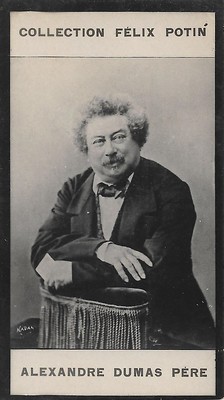
French minicard in the first series of Collection Felix Potin. Photo: Nadar. Portrait of the writer Alexandre Dumas père. The image is much older than the collector's card.

French minicard in the first series of Collection Felix Potin. Photo: Eugène Pirou, Paris. Portrait of the writer Alexandre Dumas fils.

French minicard in the first series of Collection Felix Potin. Eleonora Duse.
Eleonora Duse (1858-1924), named 'La Duse', is one of the greatest stage actresses of the 19th century and early 20th century. Her performances have been considered innovative for the Italian theatre.

French minicard in the first series of Collection Felix Potin. Gabrielle Réjane.
Gabrielle Réjane (1856-1920) was a successful French stage actress and early silent film actress. She is most famous for her role of Catherine, in Sardou's play Madame Sans-Gene (1893), which she filmed twice.

French minicard in the first series of Collection Felix Potin. Aimée Tessandier.
Aimée Tessandier (1853-1923) was a French actress. It was in Reims that Jacques Offenbach, who came specially from Paris, offered Aimée Tessandier an engagement. In 1885 she performed 'L'Arlésienne', which had no less than 500 performances.

French minicard in the first series of Collection Felix Potin. Jean Coquelin.
Jean Coquelin (1865-1944) was the son of the famous stage actor Benoit Constant Coquelin. He started at the Theatre Francois, debuting in 1890, then moving on to the Renaissance and finally the Porte Saint-Martin which was run by his father but taken over by him in 1901. There he created the character of Raigoné in Edmond Rostand's 'Cyrano de Bergerac', the major play in which his father had performed. Coquelin and his father played together in the stage play 'La Dame de Monsoreau', after a novel of Alexandre Dumas, turned into a stage play in 1860.

French minicard in the first series of Collection Felix Potin. Paul Mounet
Paul Mounet (1847–1922)was a French actor of the Comédie Française, who also acted in various Film d’Art films around 1910. He was the younger brother of actor Jean Mounet-Sully.

French minicard in the first series of Collection Felix Potin. Albert Lambert.
French stage and screen actor Albert Lambert (1865-1941) was for a long time part of the Comédie-Française, but he also played in several early French Film d’Art films, first of all, L'Assassinat du Duc de Guise (1908).

French minicard in the first series of Collection Felix Potin. Rose Caron.
Rose Caron (1857-1930) was a classical singer with a beautiful soprano voice and a good physique. The French singer was famous in particular for her performances of the Wagnerian repertoire. She joined the Paris Opéra from 1885 to 1887 and took part in many premieres, such as 'Salammbô'.

French minicard in the first series of Collection Felix Potin. Gyp.
Sibylle Aimée Marie-Antoinette Gabrielle de Riquetti de Mirabeau, Countess de Martel de Janville (1849-1932) was a French writer who published her works under the pseudonym Gyp.

French minicard in the first series of Collection Felix Potin. Aristide Bruant.
Aristide Bruant (1851-1925) was a French cabaret singer, writer, comedian and nightclub owner who became very well known through the posters of Henri de Toulouse-Lautrec, in which he can be seen as a man in a red scarf and black coat.

French minicard in the first series of Collection Felix Potin. Photo: Paul Nadar. Jean Louis Ernest Meissonier.
Jean Louis Ernest Meissonier (1815-1891) was one of the most famous French painters in the 1850s and 1860s.
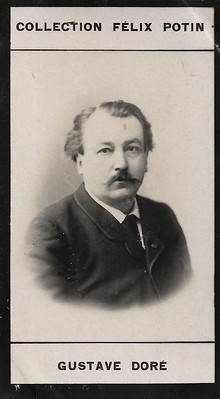
French minicard in the first series of Collection Felix Potin. Gustave Doré.
Gustave Doré (1832-1883) was a French illustrator, caricaturist, painter, lithographer and sculptor. Doré published his first illustrated story at the age of 15. He became a book illustrator in Paris, where he drew the works of Rabelais, Balzac and Dante, among others. In 1853, he was asked to illustrate the works of Lord Byron. This was followed by other work for British publishers, including a newly illustrated English Bible. He also illustrated a large edition of 'The Raven' by Edgar Allan Poe. Doré's English Bible (1865) was a great success, and in 1867 he held a major exhibition of his work in London.
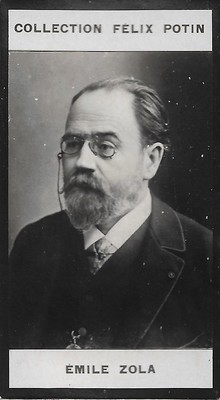
French minicard in the first series of Collection Felix Potin. Émile Zola.
Émile Zola (1840-1902) was a French writer and journalist. Considered the leader of naturalism, he is one of the most popular French novelists, the most published, translated and commented on worldwide. He has left a lasting mark on the French literary world. His novels have been adapted into numerous films and television shows. His life and work have been the subject of numerous historical studies.

French minicard in the first series of Collection Felix Potin. Henrik Ibsen.
Henrik Johan Ibsen (1828-1906) was a Norwegian playwright and theatre director. As one of the founders of modernism in theatre, Ibsen is often referred to as "the father of realism" and he was one of the most influential playwrights of his time. His major works include 'Brand', 'Peer Gynt', 'An Enemy of the People', 'A Doll's House', 'Hedda Gabler', 'Ghosts', 'The Wild Duck', and 'Rosmersholm'. Ibsen is the most frequently performed dramatist in the world after Shakespeare.

French minicard in the first series of Collection Felix Potin. Photo: Nadar. Georges Rodenbach.
Georges Rodenbach (1855-1898) was a French-speaking Belgian writer and poet. Rodenbach was one of the first prominent Belgian men of letters to embrace French symbolist poetry. Although he died at the age of forty-three, Georges Rodenbach occupies a prominent place in the history of international symbolism, with his poetry collections 'Le Règne du Silence' (1891), 'Les Vies encloses' (1896), 'Le Miroir du ciel natal' (1898), and his well-known novel 'Bruges-la-Morte' (1892).

French minicard in the first series of Collection Felix Potin. Jaap Eden.
Jaap Eden (1873-1925) was a Dutch athlete. He is the only male athlete to win gold at the world championships in both speed skating (three times: 1893, 1895, 1896) and bicycle racing (two times: 1894, 1895).

French minicard in the first series of Collection Felix Potin. Segond-Weber.
Caroline-Eugénie Weber, known as Mme Segond-Weber (1867-1945,) entered the Comédie Française in 1887, became sociétaire in 1902, and sociétaire honoraire in 1927. She was one of the 'monstres sacrés' of the French stage.

French minicard in the first series of Collection Felix Potin. Photo: Bary, Paris. Adelina Patti.
Adelina Patti (1843-1919) was an Italian 19th-century opera singer, who earned huge fees at the height of her career in the music capitals of Europe and America. She first sang in public as a child in 1851 and gave her last performance before an audience in 1914. Patti remains one of the most famous sopranos in history, owing to the purity and beauty of her lyrical voice and the unmatched quality of her bel canto technique. The composer Giuseppe Verdi, writing in 1877, described her as being perhaps the finest singer who had ever lived and a "stupendous artist". Verdi's admiration for Patti's talent was shared by numerous music critics and social commentators of her era.

French minicard in the first series of Collection Felix Potin. Pietro Mascagni.
Pietro Mascagni (1863-1945) was an Italian composer primarily known for his operas. His 1890 masterpiece 'Cavalleria Rusticana' caused one of the greatest sensations in opera history and single-handedly ushered in the Verismo movement in Italian dramatic music. While it was often held that Mascagni, like Ruggero Leoncavallo, was a "one-opera man" who could never repeat his first success, 'L'amico Fritz' and 'Iris' have remained in the repertoire in Europe (especially in Italy) since their premieres. In 1915 Mascagni wrote the music for Nino Oxilia's film Rapsodia Satanica, starring Lyda Borelli.

French minicard in the first series of Collection Felix Potin. Photo: G. Camus, Paris. Maurice de Féraudy.
Maurice de Féraudy (1859-1932) was an actor of the Comédie-Française and a French director. He was also a notable actor and director in French silent cinema.

French minicard in the first series of Collection Felix Potin. Photo: Boyer, Paris. Charles Le Bargy.
Charles Le Bargy (1858-1936) was already a famous stage actor in his time, performing at the Comedie Française when he debuted in cinema as the perfidious king Henry III in L'Assassinat du Duc de Guise (1908).
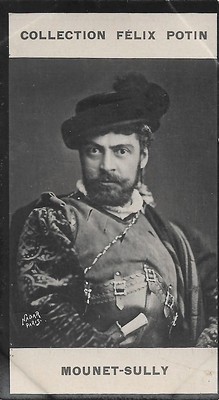
French minicard in the first series of Collection Felix Potin. Photo: Nadar, Paris. Jean Mounet-Sully.
Jean Mounet-Sully (1841-1916) was one of the biggest French theatre actors in the late 19th and early 20th centuries. At the end of his life, he played in several French Film d'Art films, some based on previous stage successes of Mounet-Sully. He was the brother of the actor Paul Mounet.

French minicard in the first series of Collection Felix Potin. Photo: Loescher & Petsch, Berlin. Otto von Bismarck.
Otto, Prince of Bismarck, Count of Bismarck-Schönhausen, Duke of Lauenburg (1815-1898), was a conservative German statesman and diplomat. From his origins in the upper class of Junker landowners, Bismarck rose rapidly in Prussian politics, and from 1862 to 1890 he was the minister-president and foreign minister of Prussia. Before his rise to the executive, he was the Prussian ambassador to Russia and France and served in both houses of the Prussian Parliament. He masterminded the unification of Germany in 1871 and served as the first Chancellor of the German Empire until 1890, in which capacity he dominated European affairs. He was nicknamed The Iron Chancellor.

French minicard in the first series of Collection Felix Potin. Famous painters of the late 19th century. Albert Besnard.
Paul-Albert Besnard (1849-1934) was a French painter and printmaker. Besnard made his name mainly as a painter of female portraits, in an unconventional, sometimes dreamy style, a kind of mixture between classicism and impressionism, typical of the belle époque, but also with influences of Thomas Gainsborough and Joshua Reynolds. He exhibited his portraits with great regularity and success in the Paris Salon.

French minicard in the first series of Collection Felix Potin. Famous painters of the late 19th century. Photo: Pirou, Paris. Alexandre Cabanel.
Alexandre Cabanel (1823-1889) was a French painter. He painted historical, classical and religious scenes in the academic style, and was also a well-known portrait painter. Cabanel is one of the most important representatives of the so-called "art pompier". He was also the favourite painter of Emperor Napoleon III, whose portrait he painted in 1865. His 1863 painting 'The Birth of Venus' is one of the best-known examples of 19th-century academic painting and was bought by Napoleon III. Other famous works are his 'The Death of Francesca da Rimini and Paolo Malatesta' (1870), 'Phaedra' (1880) and 'Cleopatra Testing Poisons on Condemned Prisoners' (1887). According to the Dictionary of Art (1996), "he was elected regularly to the Salon jury and his pupils could be counted by the hundred at the Salons. Through them, Cabanel did more than any other artist of his generation to form the character of belle époque French painting."

French minicard in the first series of Collection Felix Potin. Famous painters of the late 19th century. Photo: Nadar, Paris. Alfred Stevens.
Alfred Émile Léopold Stevens (1823-1906) was a Belgian painter, known for his paintings of elegant modern women. After gaining attention early in his career with a social realist painting depicting the plight of poor vagrants, he achieved great critical and popular success with his scenes of upper-middle-class Parisian life. In their realistic style and careful finish, his works reveal the influence of 17th-century Dutch genre painting. In 2009, a large overview of his work was exhibited in Brussels (Royal Museum of Fine Arts) and Amsterdam (Van Gogh Museum). Examples are e.g. 'Will You Go Out With Me Fido?' (1859), 'The Lady in Pink' (1866), 'The Parisian Sphinx' (1875–1877), and 'Maria Magdalena' (1887).

French minicard in the first series of Collection Felix Potin. Famous painters of the late 19th century. Photo: Nadar, Paris. Alphonse de Neuville.
Alphonse-Marie-Adolphe de Neuville (1835-1885) was a French academic painter who studied under Eugène Delacroix. His dramatic and intensely patriotic subjects illustrated episodes from the Franco-Prussian War, the Crimean War, the Zulu War, and portraits of soldiers. His fame spread rapidly and was increased by 'Les dernières cartouches/The Last Cartridges' (1873), memorializing an episode involving the Blue Division of the French marines, in which it is easy to discern the vast difference between the conventional treatment of military subjects, as practised by Horace Vernet, and that of a man who had lived the life that he painted. Between 1897 and the early 1900s several film adaptations of 'The Last Cartridges' were made by e.g. Lumière, Pathé, and Méliès. From 1881 to 1883, De Neuville collaborated with Édouard Detaille in the creation of two battle panoramas: The Battle of Champigny and The Battle of Rezonville. At the recent exhibition 'Enfin le cinéma' (2021) at Musée d'Orsay both his painting and the film versions were on show.

French minicard in the first series of Collection Felix Potin. Famous painters of the late 19th century. Photo: Pierre Petit, Paris. Benjamin-Constant.
Jean-Joseph Benjamin-Constant (1845-1902), also known as Benjamin-Constant), was a French painter and etcher best known for his Oriental subjects and portraits. A journey to Morocco in 1872 strongly influenced his early artistic development and led him to produce Romantic scenes under the spell of Orientalism. His large canvas, 'The Entrance of Mahomet II into Constantinople' (Musée des Augustins Toulouse), received a medal at the Paris Salon in 1876. Other acclaimed works were his portraits of Judith, Herodias, and Empress Theodora. In later life, he focused on mural decorations and portraits and became a favourite of the British aristocracy. The Italian silent film Il fiacre No. 13 (1917) shows the salon staging of a tableau vivant of Benjamin-Constant's Empress Theodora. In 2015 the Montreal Museum of Fine Arts had a big show with the works of Benjamin-Constant, entitled 'Marvels and Mirages of Orientalism'. It was the first major retrospective of Benjamin-Constant in recent times.
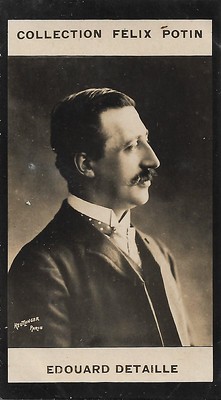
French minicard in the first series of Collection Felix Potin. Famous painters of the late 19th century. Photo: Reutlinger, Paris. Édouard Detaille.
Jean-Baptiste Édouard Detaille (1848-1912) was a French academic painter and military artist noted for his precision and realistic detail. He was regarded as the "semi-official artist of the French army". Detaille had studied with Meissonnier, who would have a lasting influence on him regarding an eye for accuracy and precision. After his own fights in the Franco-Prussian war of 1870-71, this became the topic for many of his paintings, as well as two panoramas he painted together with Alphonse Neuville.
No comments:
Post a Comment